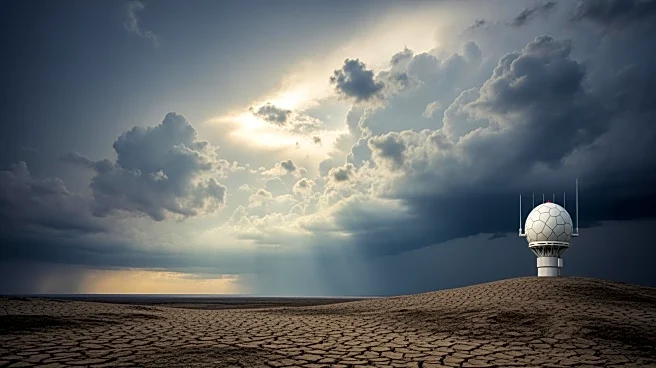What's Happening?
Iran is facing its worst drought in decades, with water levels in major reservoirs and lakes at record lows. In response, Iranian authorities have begun cloud seeding operations to induce rainfall, particularly
over the Urmia lake basin. This initiative comes as Tehran's Amirkabir dam reports water levels at only 8% of capacity. The drought has been exacerbated by mismanagement, overconsumption, and an inefficient agricultural sector. President Masoud Pezeshkian has warned that if sufficient rainfall does not occur soon, Tehran may face water rationing and potential evacuations. The situation has been described as a state of failure, with experts cautioning about long-term water bankruptcy if current trends persist.
Why It's Important?
The severe drought in Iran highlights the critical challenges posed by climate change and resource mismanagement. The potential water shortages in Tehran could lead to significant social and economic disruptions, affecting millions of residents and businesses. The cloud seeding initiative underscores the urgency of finding immediate solutions to mitigate the crisis. However, it also raises questions about the sustainability and effectiveness of such measures. The situation in Iran serves as a stark reminder of the broader implications of environmental degradation and the need for comprehensive water management strategies.
What's Next?
Iranian authorities are considering further cloud seeding operations in east and west Azerbaijan. Additionally, plans to penalize excessive water consumption by households and businesses are underway. The government may also implement water rationing in Tehran if rainfall remains insufficient. These measures could provoke public concern and require careful management to avoid social unrest. The international community may watch closely, as Iran's water crisis could have regional implications, potentially affecting neighboring countries and prompting discussions on collaborative water management solutions.
Beyond the Headlines
The drought in Iran highlights deeper issues related to environmental sustainability and governance. The reliance on cloud seeding reflects a reactive approach to crisis management, rather than addressing root causes such as inefficient agricultural practices and water resource mismanagement. This situation may prompt broader discussions on the ethical and environmental implications of artificial weather modification. Long-term solutions will likely require significant policy shifts and investment in sustainable water infrastructure and conservation practices.












